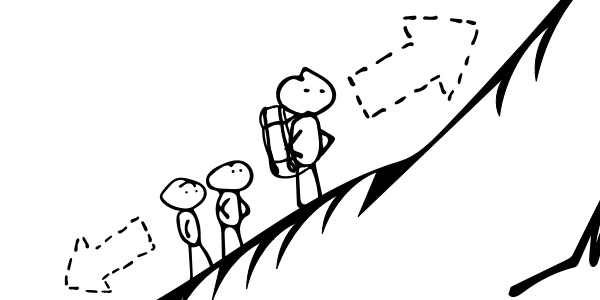
Developing strategic statements and summaries for the direction of your brand is an essential process for every business. It provides tools to align your team, build trust with your customers, and articulate your brand’s direction in a concise and memorable way.
Here’s a short exchange I had with David Cancel on the value of big picture brand strategy. David is the CEO of the fast-growing startup Drift, was named Entrepreneur of the Year by Ernst & Young, and is a huge believer in the value of developing your brand:

It’s no wonder that in 4 short years his company has acquired 150K customers and grown to a team of 250+.
And while every brand can be strengthened from big picture strategy, if the output of that work isn’t clear the benefits get diminished.
The first trap is to jam too much information into the ideas. This bloat transforms simple statements into vague, wordy paragraphs that are hard to understand and impossible to remember.
The other big challenge is to make sure each strategic concept gets used in a distinct way.
In non-business conversations, words like purpose and mission might get used interchangeably. The thesaurus even lists them as synonyms. But that lack of intuitive separation leads to confusion when it comes to your brand.
To keep these concepts distinct and maximize the value they provide you have to assign clear roles for each.
There’s lots of great thinking out there around big picture strategy, from folks like Jim Collins and Simon Sinek.
Our website at Map & Fire also has a Field Guide to help as well.
The intent of this breakdown isn’t to replicate those resources. Instead, this is a simple summary to show how to use each concept and how they’re distinct.
Each Brand Direction concept will include the following:
- Time Horizon: From the biggest, broadest time scale down to the immediate
- Short Definition: A simple way to think about the concept
- Benefit: Why you should care about this concept for your brand
- Example: Map & Fire’s own use of the concept
Core Purpose: Your Brand’s “Forever”

Time Horizon:
We label Core Purpose as “Forever” because it represents a driving force that’s always present regardless of what your business achieves or how long it’s around.
Short Definition:
It’s the aspirational reason why your company exists. It lives beyond financial goals and doesn’t include any methods, means, or specific approaches or executions.
Benefit:
It acts as a north star to focus everything you do. It should be a source of inspiration and guidance that outlasts any ups, downs, shifts, or pivots,
Map & Fire’s Core Purpose:
“Empower and elevate business leaders to achieve their goals.”
Note: Map & Fire’s Core Purpose isn’t just to do great work for clients. We want to provide new outlooks and insights on how they see their business so they can succeed on their own.
Vision Statement: Your Brand’s “One Day”

Time Horizon:
We label Vision as “One Day” because it serves a time frame that could happen eventually, but is still far off in an abstract sense.
Short Definition:
This is your brand’s “envisioned future”. It’s a description of what the world could be like if you achieve everything you set out to do. It speaks to the impact you’ll make in the lives of your customers, not just the future state of your own company.
Benefit:
It gets you thinking big and long term. It opens your mind up to the greater scale of what your business could accomplish if taken to its fullest extreme. In doing that, it provides a check to see if what you’re doing today feeds into that future.
Map & Fire’s Vision Statement:
“The resources to create a smart, successful brand are accessible and easy to use for every business leader.”
Note: Map & Fire’s Vision is to make sure a person’s ability to start or contribute to a company’s success is only limited by their own grit and determination. The tools and resources they need to succeed are available, easy to understand, and immediately useful.
Mission Statement: Your Brand’s “Today”

Time Horizon:
We label Mission as “Today” because it speaks to the specific, current actions a brand is working on.
Short Definition:
Your Mission Statement describes exactly how you’ve put your purpose into action, along with who benefits from your work. It outlines your actions in simple, clear language that’s specific to your brand.
Benefit:
Your Mission is where your brand moves from the abstract to the concrete. This focuses on the methods you use to enable your greater purpose. It aligns your team’s efforts and communicates to your audience how your brand provides value to them.
Map & Fire’s Mission Statement:
“Provide data, creative, and strategy resources that empower business leaders to build high-growth brands fueled by aligned teams and loyal customers.”
Note: Map & Fire’s Mission is to help business leaders use their brand as the mechanism to connect with their customers. We use a process-driven approach, so that our customers understand how we help them define their brand and how to take that work and build on it for years to come.
Core Values: Your Brand’s “Right Now”

Time Horizon:
We label Core Values as “Right This Second” because these are the principles that guide everyday decisions as they happen in the moment.
Short Definition:
Core Values describe what we believe and how we behave. They’re a brand’s standards of conduct even (and especially) when things get difficult.
Benefit:
Core Values are independent of specific business activities. It’s a way to define the fabric of your brand’s culture and how it operates. It’s a tool that instills a sense of consistency and builds trust for your team and with your customers. It should be obvious how decisions align with your values. If a decision isn’t aligned, it provides a mechanism to recognize the issue and remedy it.
Map & Fire Example:
- Evidence Over Ego: When it comes to decisions and recommendations, we use research, data, and an outside perspective to provide an objective point of view.
- Excellence Through Empowerment: Our goal isn’t just to deliver great work but to share how things work. We want to provide resources, tools, and knowledge to encourage success beyond our engagements.
- Fast And Focused: To maximize efficiency, we keep our processes and methods lean so that we can put strategies into practice and learn from them as soon as possible.
- Collaborators At Heart: Our best work and best relationships have always come from openly sharing ideas and working on challenges together. Swooping in and dropping off a solution (even a good one) rarely works.
- Naturally Curious: We’re always excited to learn as much as we can about new businesses and teams to help them find untapped opportunities.
- Make It Fun: If you can laugh together, you can relax together. When you’re relaxed you’re more likely to share ideas and do your best work.
Note: The key theme of empowerment that starts in our purpose continues all the way through to our values. In addition, collaboration, efficiency, process, curiosity, and fun are all central to what we believe in to deliver great work.
Does Every Brand Need All Of These?
In the sense that going through the exercise of defining these concepts is critical to get clear on where you’re going, what you hope to accomplish, and how you’ll get there — yes, every brand should take the time to define these.
Without thinking through these ideas and writing them down, it’s impossible to maintain a clear direction in your own head, let alone with a team of people.
It’s true that statements and lists of values don’t mean much on their own. The actual benefits come from how they’re embodied by your brand.
But if you don’t explicitly share the foundation of what you’re striving for, how can you expect everyone to embody the same things? How can you maintain consistency? What gauge will you have to evaluate if things are on or off course?
Once you’ve defined these concepts, you can then decide which statements or summaries you want your brand to focus on and rally behind.
Your Core Purpose might serve mainly as a guide for the founders.
Your Vision Statement might get shared and discussed only with your employees.
Your Mission Statement and Core Values may be pieces that get placed on your website so that your team and customers can consume them.
It’s up to you to decide the most effective way to take advantage of these tools.
The keys are to:
- Define them
- Share and discuss them
- Put them into action so that you and your team can embody them
Expect Evolution
One last note. While we design certain concepts like your Core Purpose and Core Values to be evergreen, nothing is ever set in stone.
As your business evolves, you should revisit these concepts to make sure they still represent the direction and philosophy of the brand. As you grow, don’t be afraid to make tweaks, get new inputs, and involve your team!
Your brand strategy should be a living, breathing, thing. If it doesn’t reflect what your business stands for today, it can’t keep your team aligned for the long run.

Crystallize Your Brand’s Unique Position
If you’re ready to define your brand’s big picture strategy, reach out for a free consultation. We’ll help you transform your best business thinking into an actionable, shareable, growth-oriented guide, click below to learn more about the Brand Guidebook process.

